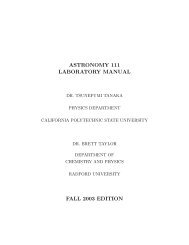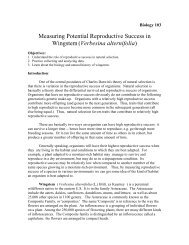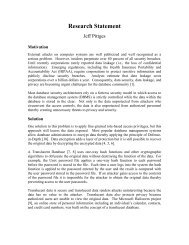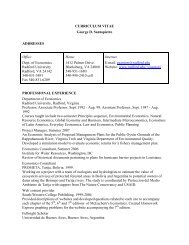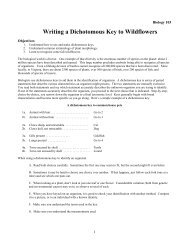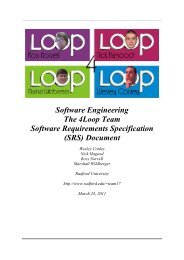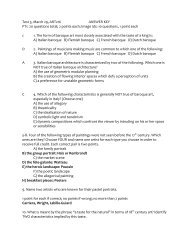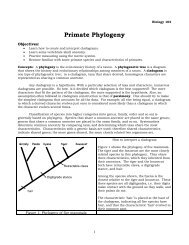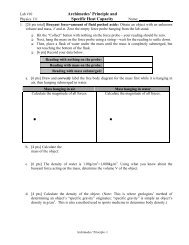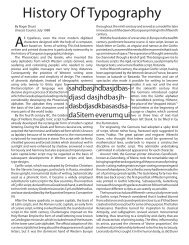Non-negative solutions of ODEs - Radford University
Non-negative solutions of ODEs - Radford University
Non-negative solutions of ODEs - Radford University
Create successful ePaper yourself
Turn your PDF publications into a flip-book with our unique Google optimized e-Paper software.
Applied Mathematics and Computation 170 (2005) 556–569<br />
www.elsevier.com/locate/amc<br />
<strong>Non</strong>-<strong>negative</strong> <strong>solutions</strong> <strong>of</strong> <strong>ODEs</strong><br />
L.F. Shampine a , S. Thompson b, *,<br />
J.A. Kierzenka c , G.D. Byrne d<br />
a Department <strong>of</strong> Mathematics, Southern Methodist <strong>University</strong>, Dallas, TX 75275, USA<br />
b Department <strong>of</strong> Mathematics and Statistics, <strong>Radford</strong> <strong>University</strong>, Walker Hall,<br />
<strong>Radford</strong>, VA 24142, USA<br />
c The MathWorks, Inc., 3 Apple Hill, Natick, MA 01760, USA<br />
d Departments <strong>of</strong> Applied Mathematics and Chemical & Environmental Engineering,<br />
Illinois Institute <strong>of</strong> Technology, Chicago, IL 60616, USA<br />
Abstract<br />
This paper discusses procedures for enforcing non-negativity in a range <strong>of</strong> codes for<br />
solving ordinary differential equations (<strong>ODEs</strong>). This codes implement both one-step and<br />
multistep methods, all <strong>of</strong> which use continuous extensions and have event finding capabilities.<br />
Examples are given.<br />
Ó 2005 Published by Elsevier Inc.<br />
Keywords: Ordinary differential equations; Initial value problems<br />
* Corresponding author.<br />
E-mail addresses: lshampin@mail.smu.edu (L.F. Shampine), thompson@radford.edu (S.<br />
Thompson), jacek.kierzenka@mathworks.com (J.A. Kierzenka), gdbyrne847@yahoo.com (G.D.<br />
Byrne).<br />
0096-3003/$ - see front matter Ó 2005 Published by ElsevierInc.<br />
doi:10.1016/j.amc.2004.12.011
1. Introduction<br />
L.F. Shampine et al. / Appl. Math. Comput. 170 (2005) 556–569 557<br />
Users do not like it when a program for solving an initial value problem<br />
(IVP) for a system <strong>of</strong> ordinary differential equations (<strong>ODEs</strong>)<br />
y 0 ðtÞ ¼f ðt; yðtÞÞ; yðt 0 Þ¼y 0 ð1Þ<br />
returns a <strong>negative</strong> approximation to a quantity like population, concentration,<br />
orthe like that is intrinsically non-<strong>negative</strong>. Unfortunately, no standard<br />
numerical method provides this qualitative property automatically. Users are<br />
<strong>of</strong>ten understanding when a solver produces small <strong>negative</strong> approximate <strong>solutions</strong>.<br />
For instance, in their discussion <strong>of</strong> the numerical solution <strong>of</strong> a diurnal<br />
kinetics problem, Hindmarsh and Byrne [9] write ‘‘Note that the nighttime values<br />
<strong>of</strong> the y i are essentially zero, but that the computed values include some<br />
small <strong>negative</strong> numbers. These are unphysical, but should cause no concern,<br />
since they are well within the requested error tolerance.’’<br />
Even if users are willing to accept <strong>negative</strong> approximations that are not<br />
physically meaningful, some models are unstable then and the computation<br />
will fail. A volume edited by Lapidus and Schiesser contains three articles<br />
[7–9] that take up examples <strong>of</strong> this kind. In one <strong>of</strong> the articles Enright and Hull<br />
[8] observe in their testing <strong>of</strong> programs for solving stiff IVPs that ‘‘On other<br />
problems the method itself has detected some difficulty and abandoned the<br />
integration. This can happen for example when solving kinetics problems at relaxed<br />
error tolerances; <strong>negative</strong> concentrations may be introduced which cause<br />
the problem to become mathematically unstable’’. The examples <strong>of</strong> these articles<br />
might leave the impression that all IVPs <strong>of</strong> this kind are stiff, but that is not<br />
so. Indeed, Huxel [10] has communicated to the authors two IVPs for the (nonstiff)<br />
Lotka–Volterra equations that behave in just this way when solved with<br />
ode45 [12,19] using default tolerances.<br />
Some codes have an option for the procedure that evaluates the <strong>ODEs</strong> to<br />
return a message saying that the arguments supplied are illegal. This is illustrated<br />
for DASSL [2] in the text [2, pp. 129–130] by considering the possibility<br />
<strong>of</strong> the <strong>ODEs</strong> being undefined when a component <strong>of</strong> y is <strong>negative</strong>. The BzzOde<br />
[4] solverallows components <strong>of</strong> the solution to be constrained by upperand<br />
lower bounds. It takes pains to avoid calling the procedure with arguments that<br />
do not satisfy the bounds.<br />
Although a non-negativity constraint is most common, a more general<br />
inequality constraint <strong>of</strong> the form y i (t) P g i (t) fora given (piecewise smooth)<br />
function g i (t) can be handled in the same way. Indeed, the task is formulated<br />
this way in [15], which may be the first paper to justify a natural scheme in useful<br />
circumstances, but here we assume that a new variable is used to reduce the<br />
task to imposing non-negativity. The scheme <strong>of</strong> [15,16] is to project the tentative<br />
solution at each step onto the constraints. For the one-step methods and a
558 L.F. Shampine et al. / Appl. Math. Comput. 170 (2005) 556–569<br />
useful class <strong>of</strong> problems considered in [15,16], this natural approach is successful.<br />
However, it is not successful for other kinds <strong>of</strong> methods and problems. Indeed,<br />
Brenan et al. [2, p. 131] write that ‘‘For a very few problems in<br />
applications whose analytic <strong>solutions</strong> are always positive, we have found that<br />
it is crucial to avoid small <strong>negative</strong> <strong>solutions</strong> which can arise due to truncation<br />
and round<strong>of</strong>f errors. There is an option in DASSL to enforce non-negativity <strong>of</strong><br />
the solution. However, we strongly recommend against using this option except<br />
when the code fails orhas excessive difficulty without it.’’ We are not so<br />
pessimistic about imposing non-negativity constraints. In fact, the warning<br />
found in the prologue <strong>of</strong> DASSL itself is not nearly this strong. While it is<br />
true that approaching a constraint can be problematic even for robust solvers, it<br />
is possible to handle the difficulties that arise in a reasonably general<br />
manner.<br />
Ourgoal was to develop an approach to imposing non-negativity constraints<br />
so broadly applicable that it could be used to add the option to all<br />
the codes <strong>of</strong> the MATLAB ODE Suite [19]. In addition, we wished to incorporate<br />
provisions for enforcing non-negativity in VODE_F90 [5], a Fortran 90 version<br />
<strong>of</strong> VODE [3]. The wide range <strong>of</strong> methods raises many issues. A fundamental<br />
difficulty is that the constraint is on the global solution, but codes proceed a<br />
step at a time and work with a local solution. This is especially clear with<br />
one-step methods for which local <strong>solutions</strong> that behave differently from the global<br />
solution can pr<strong>of</strong>oundly affect the integration. Although multistep methods<br />
work with a global solution, their estimators depend on a smooth behavior <strong>of</strong><br />
the error. Perturbing the solution affects that basic assumption, hence the reliability<br />
<strong>of</strong> the error estimates. Other issues are raised by the capabilities <strong>of</strong> these<br />
modern solvers: they all have continuous extensions that are used to produce<br />
approximate <strong>solutions</strong> throughout the span <strong>of</strong> each step. They all exploit this<br />
capability to provide an event location facility. Because <strong>of</strong> these capabilities, we<br />
must considerhow to impose non-negativity constraints not merely at mesh<br />
points, but everywhere.<br />
Several <strong>of</strong> the codes <strong>of</strong> [19] can solve differential-algebraic equations (DAEs)<br />
<strong>of</strong> index one that arise when the mass matrix M(t,y) in<br />
Mðt; yÞy 0 ðtÞ ¼f ðt; yðtÞÞ<br />
ð2Þ<br />
is singular. Imposing non-negativity raises new issues when solving a DAE. A<br />
critical one is computing numerical <strong>solutions</strong> that are consistent. The ode15i<br />
program <strong>of</strong> [19] solves fully implicit <strong>ODEs</strong>. It also presents a number <strong>of</strong> difficulties<br />
forourapproach to imposing non-negativity constraints. An obvious<br />
one is that the form precludes our key step <strong>of</strong> redefining the equations. Though<br />
we are not pessimistic about the prospects for dealing with these issues, we do<br />
not take them up here. We consider here only the numerical solution <strong>of</strong> <strong>ODEs</strong><br />
that have the form (2) with non-singular M(t,y). This excludes ode15i and<br />
several <strong>of</strong> the programs when they are applied to DAEs.
2. Illuminating examples<br />
L.F. Shampine et al. / Appl. Math. Comput. 170 (2005) 556–569 559<br />
The nature <strong>of</strong> the error control is fundamental to the task. If it requires the<br />
accurate computation <strong>of</strong> a solution component that is positive, the constraint<br />
that it be non-<strong>negative</strong> will be satisfied automatically. However, if a component<br />
decays to zero and the control allows any absolute error at all, eventually the<br />
code is responsible only for producing an approximation that is sufficiently<br />
small in magnitude. To be clearabout this fundamental matter, the issue <strong>of</strong><br />
imposing non-negativity arises only when a solution component decays to<br />
the point that it is somewhat smaller than an absolute error tolerance. When<br />
a component is sufficiently small compared to the absolute error tolerance,<br />
we are asking for no relative accuracy in this component, a fact that we would<br />
like to exploit in selecting the step size. In a survey [1, Section 2.4] on combustion,<br />
Aiken reports that Karasalo and Kurylo [11] found it betterto impose<br />
non-negativity than to reduce the tolerance to achieve it as a byproduct.<br />
We now considera number<strong>of</strong> examples that illuminate the difficulties <strong>of</strong> the<br />
task and serve to test our algorithms. We begin by illustrating semi-stable IVPs<br />
with<br />
y 0 ¼ jyj; yð0Þ ¼1: ð3Þ<br />
The solution e t is positive, but decays to zero. Notice what happens if a<br />
code generates an approximation y*
560 L.F. Shampine et al. / Appl. Math. Comput. 170 (2005) 556–569<br />
Two examples <strong>of</strong> semi-stable, non-stiff problems provided by Huxel [10]<br />
reinforce our comments about the error control. The <strong>solutions</strong> are oscillatory<br />
and in portions <strong>of</strong> the integration, some components approach zero. If the<br />
absolute error tolerances on these components are sufficiently small to distinguish<br />
them from zero, the integration is routine (though relatively expensive).<br />
With default tolerances, some <strong>of</strong> the solvers <strong>of</strong> [19] compute <strong>negative</strong> approximations<br />
for these examples and the integration fails because the IVPs are only<br />
semi-stable. We use both problems for test purposes and state only one here to<br />
make anotherpoint. The <strong>ODEs</strong><br />
<br />
y 0 1 ¼ 0:5y y<br />
<br />
1 1 1<br />
0:1y<br />
20<br />
1 y 2 ;<br />
y 0 2 ¼ 0:01y 1y 2 0:001y 2<br />
are to be integrated over [0,870] with initial values (25, 5) T . Notice that if a solver<br />
should produce an approximation y 1<br />
< 0att* and then impose the non-negativity<br />
constraint by increasing the approximation to zero, the solution <strong>of</strong> the<br />
<strong>ODEs</strong> through ðt ; ð0; y 2 ÞT Þ has y 1 (t) 0 for t P t*. The same happens if it<br />
should produce an approximation y 2<br />
< 0 that is projected to the constraint <strong>of</strong><br />
zero. Though projection results in a solution that satisfies the non-negativity<br />
constraints and the local error tolerances specified by the user, this solution does<br />
not have the desired qualitative behavior. This is a consequence <strong>of</strong> the user specifying<br />
a tolerance too lax to distinguish <strong>solutions</strong> that are qualitatively different,<br />
not a defect <strong>of</strong> the numerical scheme for guaranteeing non-<strong>negative</strong> <strong>solutions</strong>.<br />
Starting on, or even approaching the boundary <strong>of</strong> the region <strong>of</strong> definition <strong>of</strong><br />
the <strong>ODEs</strong> is problematic because both theory and practice require that f(t,y)be<br />
smooth in a ball about the initial point. An example studied at length in [17,<br />
p. 28 ff.] is the IVP<br />
p<br />
y 0 ¼<br />
ffiffiffiffiffiffiffiffiffiffiffiffi<br />
1 y 2 ¼ f ðt; yÞ; yð0Þ ¼0: ð5Þ<br />
The solution yðtÞ ¼sin t increases to 1 as t increases to p/2. The function f is<br />
not defined for y > 1 and it does not satisfy a Lipschitz condition on any region<br />
which includes y = 1. This reflects the fact that the solution <strong>of</strong> the IVP is not unique<br />
for t > p/2. Certainly it would be reasonable to ask that a solver not generate<br />
any approximations bigger than 1, a task that we can easily reformulate<br />
as requiring that in a different variable, the solution is to be non-<strong>negative</strong>. Methods<br />
appropriate for stiff problems make use <strong>of</strong> Jacobians that are commonly<br />
approximated by finite differences. Schemes for approximating a Jacobian at<br />
(t*,y*) assume that the function f is smooth nearthis point. They evaluate f<br />
at nearby points, and one <strong>of</strong> these points might be illegal. An example that arose<br />
in industrial practice [17, p. 11] shows that there can be difficulties with f as well.<br />
Some <strong>of</strong> the initial concentrations in this reaction model were equal to zero. Because<br />
<strong>negative</strong> concentrations are meaningless, the scientists who formulated<br />
the model did not provide for this when they coded the <strong>ODEs</strong>. However, the
implicit Runge–Kutta method used to solve the problem formed an intermediate<br />
approximation that was <strong>negative</strong> and the computation failed. A lesson to be<br />
learned from this is that some kinds <strong>of</strong> numerical methods evaluate approximate<br />
<strong>solutions</strong> in the course <strong>of</strong> taking a step and we must consider the possibility<br />
<strong>of</strong> these intermediate approximations violating non-negativity constraints.<br />
Serious difficulties arise when the local <strong>solutions</strong> do not share the behavior<br />
<strong>of</strong> the desired global solution. A case in point is to integrate<br />
y 0 ¼ e t ; yð0Þ ¼1 ð6Þ<br />
over[0, 40]. The solution e t is positive, but decays to zero. If a code should<br />
generate an approximation at t* that is <strong>negative</strong>, projecting it back to zero<br />
means that the code is to compute a solution passing through (t*,0). The difficulty<br />
is that this local solution is <strong>negative</strong> forall t > t*. This means that the<br />
code cannot take a step <strong>of</strong> any size that does not result in a solution that violates<br />
the constraint. This contrasts with the situation for the desired solution. It<br />
is smooth and with any non-zero absolute error tolerance, permits a ‘‘large’’<br />
step size forall sufficiently large t.<br />
In the ‘‘knee problem’’ <strong>of</strong> Dahlquist et al. [6], the equation<br />
dy<br />
dt ¼ð1 tÞy y2 ; yð0Þ ¼1 ð7Þ<br />
is integrated over [0,2] for a small parameter > 0. All the computations reported<br />
here take =10 6 . The reduced problem has two <strong>solutions</strong>, namely<br />
r 1 (t) =1 t and r 2 (t) = 0. The desired solution y(t) is positive overthe interval.<br />
It stays close to r 1 (t) on the interval 0 6 t < 1 where this reduced solution is stable,<br />
bends near t = 1 where there is an exchange <strong>of</strong> stability, and then stays<br />
close to r 2 (t). Numerical results discussed in [17, p. 115 ff.] fortwo popularsolvers<br />
complement the results obtained by Dahlquist et al. [6] using anotherwellknown<br />
solver. Figure 3.2 <strong>of</strong> [17] shows striking behavior. In the first half <strong>of</strong> the<br />
integration all the solvers find it very easy to approximate r 1 (t), so they approach<br />
the change <strong>of</strong> stability with a large step size. As seen in that figure, a<br />
solvercan produce a <strong>negative</strong> solution <strong>of</strong> considerable magnitude oversome<br />
distance before it leaves the unstable solution and moves to the stable solution.<br />
We use a problem communicated to us by Schiesser [13] to illustrate the performance<br />
<strong>of</strong> the codes for a relatively large physical problem, namely a model<br />
<strong>of</strong> the convective cooling <strong>of</strong> a moving polymer sheet. There is only one partial<br />
differential equation (PDE) for the temperature T p <strong>of</strong> the polymer,<br />
oT p<br />
ot<br />
¼<br />
L.F. Shampine et al. / Appl. Math. Comput. 170 (2005) 556–569 561<br />
v oT p<br />
oz þ 2u<br />
dc p q T a<br />
T p<br />
<br />
but it leads to a relatively large system <strong>of</strong> <strong>ODEs</strong> because we solve it by the<br />
method <strong>of</strong> lines. The boundary and initial conditions are T p (0,t)=T e and<br />
ð8Þ
562 L.F. Shampine et al. / Appl. Math. Comput. 170 (2005) 556–569<br />
T p (z,0) = T 0 for0 6 t 6 40 and 0 6 z 6 z l . Here T a is the ambient temperature,<br />
z l is the length <strong>of</strong> the cooling section, z is the distance along the polymer, and<br />
there are several quantities associated with the polymer, viz. the velocity v, the<br />
thickness d, a heat transfer coefficient c p , the density q. The parameter values<br />
used in our experiments are T e = 400, T a = 25, z l = 100, T a =25, v =10,<br />
d = 0.5, c p = 0.8, q = 1.2. The steady state solution forthis problem is easily<br />
seen to be<br />
T p ¼ T a þ ðT e T a Þe Ez ;<br />
where E =2u/dqc p v. Spatial derivatives are approximated using five-point<br />
biased upwind differences [14]. The solvers are to compute this steady state<br />
solution. Physical considerations dictate that the computed T p neverexceed<br />
400. However, a combination <strong>of</strong> the high order differences used and the incompatibility<br />
<strong>of</strong> boundary and initial conditions lead to a solution that oscillates<br />
above T p = 400 nearthe beginning <strong>of</strong> the integration. To obtain a solution that<br />
does not violate this constraint, we replace the variable T p with 400 y and<br />
impose non-negativity on the new variable y.<br />
3. Imposing non-negativity constraints<br />
As remarked in Section 1, the natural approach <strong>of</strong> simply projecting to zero<br />
accepted solution values that are <strong>negative</strong> is not sufficient for all the methods<br />
and problems that interest us. Indeed, the brief discussion in Section 2 <strong>of</strong> the<br />
IVP (6) makes this clear. The same example makes clear that projecting the<br />
solution before passing it to f(t,y) is also not sufficient because the function<br />
does not depend on y. The scheme we propose makes use <strong>of</strong> a variety <strong>of</strong> devices.<br />
Certainly other schemes are possible and perhaps to be preferred for specific<br />
kinds <strong>of</strong> methods, but ours has proved successful for (nearly) all the ODE<br />
solvers <strong>of</strong> the MATLAB ODE Suite and VODE_F90 and all the examples <strong>of</strong><br />
Section 2.<br />
Because imposing non-negativity constraints is optional, we must minimize<br />
the effects <strong>of</strong> the option when it is not being used. In the first instance this is a<br />
matter <strong>of</strong> using a logical variable to avoid any extra computation when the user<br />
has not set the option. However, we want to go much further along these lines<br />
and minimize the cost when constraints are not violated. Both MATLAB and<br />
Fortran 90 have array operations that facilitate imposition <strong>of</strong> constraints.<br />
The user specifies which components are to be non-<strong>negative</strong>. Using an appropriate<br />
built-in function, it is then efficient to test whether a constraint is violated.<br />
If it is not, we avoid the computations associated with imposing<br />
constraints. As the experiments <strong>of</strong> Section 5 make concrete, it may very well<br />
happen that a code neverproduces a numerical solution that violates the con-
L.F. Shampine et al. / Appl. Math. Comput. 170 (2005) 556–569 563<br />
straints and proceeding as we do, the extra cost <strong>of</strong> insisting that the constraints<br />
be satisfied is negligible.<br />
A key idea is to redefine the differential equations outside the feasible region.<br />
Specifically, if a component y j that is required to be non-<strong>negative</strong> is passed to<br />
the procedure for evaluating f(t,y), the procedure is to return max(0, f j (t,y)) instead<br />
<strong>of</strong> f j (t,y). Redefining the <strong>ODEs</strong> outside the region <strong>of</strong> interest does no<br />
harm to the problem the user wants to solve, but it works to prevent a numerical<br />
approximation that is <strong>negative</strong> giving rise to approximations that decrease<br />
greatly. Indeed, if the differential equation implies that the component should<br />
increase, this definition will allow it to do so. A virtue <strong>of</strong> redefining the <strong>ODEs</strong> is<br />
that it is independent <strong>of</strong> the numerical method. This is valuable because <strong>of</strong> the<br />
range <strong>of</strong> methods we consider, viz. formulas that compute intermediate<br />
approximations and others that do not; explicit and implicit formulas; and formulas<br />
evaluated in a way suitable fornon-stiff IVPs and forstiff IVPs. Unfortunately,<br />
this idea is not compatible with the Rosenbrock method <strong>of</strong> ode23s.<br />
In contrast to other methods for stiff IVPs, this kind <strong>of</strong> method assumes that<br />
the Jacobian is evaluated analytically. Users prefer the convenience <strong>of</strong> numerical<br />
approximations to Jacobians, but computing an accurate approximation is<br />
a notoriously difficult task. All the other stiff solvers we consider use approximate<br />
Jacobians only in an iterative procedure to evaluate an implicit formula.<br />
For these solvers the main effect <strong>of</strong> a very poor approximation is just to cause<br />
the solverto use a smallerstep size. Redefining f in a way that induces discontinuities<br />
makes an analytical Jacobian inconvenient at best and it might not<br />
even be defined. The ode23s solverwill attempt to approximate Jacobians<br />
numerically, but in the present context, this is not likely to be satisfactory. Indeed,<br />
experimental versions <strong>of</strong> ode23s solved some test problems well enough,<br />
but proved unsatisfactory for others.<br />
If a constraint is violated by a component <strong>of</strong> an accepted approximate solution,<br />
the component is projected to zero. A difficulty that is exposed dramatically<br />
by the knee problem is that a constraint can be violated substantially by<br />
a result that passes the usual test on the local truncation error. To deal with this<br />
we introduce another measure <strong>of</strong> error. This second measure is the absolute error<br />
in the components that violate the constraint. Because this measure <strong>of</strong> error<br />
does not behave like the usual one when adjusting the step size, we use it only<br />
when the step is successful by the usual measure and unsuccessful by the second<br />
measure. Proceeding in this way, a step is accepted only if it passes the usual error<br />
test and satisfies the constraints to within the absolute error tolerance. This<br />
guarantees that any perturbation <strong>of</strong> a component to increase it to zero must be<br />
‘‘small’’. It is not clearhow to adjust the step size when a step fails because <strong>of</strong> the<br />
second error estimate since f is generally not smooth at the constraint, so we<br />
simply halve the step size then. A slightly different approach is used to handle<br />
this situation in VODE_F90. The solverchecks whetherthe predicted solution<br />
satisfies the non-negativity constraint. If it does not, the step size is halved. Once
564 L.F. Shampine et al. / Appl. Math. Comput. 170 (2005) 556–569<br />
the predicted solution is acceptable and the solver moves on to the evaluation <strong>of</strong><br />
the corrector, it proceeds in the same manner as the MATLAB solvers.<br />
Redefining the <strong>ODEs</strong> normally induces a discontinuity at constraints and<br />
correspondingly, step failures on approach to a constraint. Similarly, the second<br />
measure <strong>of</strong> error will induce failures even when the new f is smooth at a<br />
constraint. Because all the solvers we consider provide for event location, it<br />
is natural to think <strong>of</strong> locating where specified components <strong>of</strong> the solution vanish.<br />
The solvers locate events as accurately as possible, but this is unnecessary<br />
here because <strong>negative</strong> solution values are acceptable if their magnitude is less<br />
than the absolute error tolerance. The devices already suggested amount to<br />
locating such events with bisection. Fundamentally we rely upon the robustness<br />
<strong>of</strong> the solvers at a discontinuity.<br />
A quite important issue is moving along the constraint. The idea is simple enough,<br />
but its execution differs among the methods. We must be very careful<br />
about when this is done. Forone thing, the continuous extension is based on<br />
the approximate solution before projection, an issue that we discuss more fully<br />
in Section 4. Moving along the constraint amounts to a change in behavior <strong>of</strong><br />
both the theoretical and numerical <strong>solutions</strong>. To account for this we must alter<br />
what amounts to an approximate derivative. Both the explicit Runge–Kutta<br />
codes ode23 and ode45 implement methods that are FSAL (First Same As<br />
Last), meaning that they make the first evaluation <strong>of</strong> the next step as a byproduct<br />
<strong>of</strong> taking the current step. If it is actually necessary to project components to<br />
satisfy non-negativity constraints, we must go to the expense <strong>of</strong> evaluating the<br />
initial slope forthe next step using the projected solution. This suffices foronestep<br />
methods, but methods with memory cannot be handled in such a simple<br />
way. The Adams–Bashforth–Moulton PECE code ode113, the BDF code<br />
ode15s, and the corresponding methods in VODE_F90 vary the order used<br />
as well as the step size. We select the order and step size before dealing with<br />
the constraints so that the (divided) differences reflect the smoothness <strong>of</strong> the<br />
solution over several steps. For the next step we set to zero the slope and all<br />
the differences corresponding to components that violated the constraint. In effect<br />
this predicts such a component to be constant for the next step. The predictor<br />
has to be right in this sense if the error estimator is to perform correctly on<br />
the next step. Something similaris done forall the methods with memory,<br />
though the details differnotably because <strong>of</strong> the way the methods are coded.<br />
As remarked in Section 1, some codes have an option for the procedure that<br />
evaluates the <strong>ODEs</strong> to return a message saying that the arguments are illegal.<br />
Typically the code rejects such a step and tries again with half the step size. For<br />
examples like the IVP (5), we have found it more satisfactory to return nominal<br />
values when the input argument is illegal and use event location to find the<br />
boundary <strong>of</strong> legal values. Perhaps our view <strong>of</strong> this matter is influenced by<br />
the fact that all the solvers we consider have powerful event location capabilities.<br />
Under these circumstances we make no provision for illegal values when
L.F. Shampine et al. / Appl. Math. Comput. 170 (2005) 556–569 565<br />
imposing non-negativity constraints. Instead we suggest that users code the<br />
evaluation <strong>of</strong> f(t,y) so that it always returns a nominal value.<br />
4. Continuous extensions<br />
Computing approximate <strong>solutions</strong> between mesh points is a troublesome<br />
matterthat must be discussed forthe MATLAB solvers and VODE_F90 because<br />
all these codes are endowed with continuous extensions that are used to obtain<br />
output at specified points. Indeed, by default ode45 returns in each step four<br />
values obtained by evaluating a continuous extension. Because the typical continuous<br />
extension can be viewed as a polynomial interpolant, it is not surprising<br />
that even if the numerical solution satisfies the constraints at mesh points,<br />
this may not be true <strong>of</strong> the interpolant throughout the step. All the solvers we<br />
considerare endowed with event location. This capability is based on a continuous<br />
extension, so it is also affected by this issue.<br />
In the MATLAB solvers, the continuous extensions are based on data computed<br />
throughout the step before imposing non-negativity constraints with<br />
one exception; we impose the constraints on the solution at the end <strong>of</strong> the step.<br />
For interpolants that make use <strong>of</strong> this value, imposing the constraints merely<br />
shifts the interpolating polynomial up slightly because we do not accept<br />
approximations that violate the constraint very much. Shifting the interpolant<br />
reduces the likelihood <strong>of</strong> violating the constraints in the span <strong>of</strong> the step. On<br />
the otherhand, we do not adjust the slope at the end because that could represent<br />
a significant change. A disagreeable consequence <strong>of</strong> imposing non-negativity<br />
is that the continuous extensions do not connect as smoothly as usual at<br />
mesh points. We insist that the approximate solution satisfy the constraints, so<br />
when we evaluate a continuous extension, we project to zero any component<br />
that does not satisfy the constraints. If the polynomial interpolant has a component<br />
that is <strong>negative</strong> at some point in the span <strong>of</strong> a step, it is <strong>negative</strong><br />
throughout an interval. In this situation projection results in an interpolant<br />
that is continuous, but not smooth. Though the event-location schemes <strong>of</strong><br />
the solvers we consider are not affected unduly by a lack <strong>of</strong> smoothness, any<br />
event location problem can be ill-conditioned and perturbing a solution can<br />
have a surprising effect. We must accept this as being part <strong>of</strong> the userÕs problem<br />
and so beyond ourcontrol.<br />
5. Experimental results<br />
Aftermodification along the lines <strong>of</strong> Section 3, the MATLAB ODE solvers<br />
(except for ode23s) andVODE_F90 integrate all the examples <strong>of</strong> Section 2
566 L.F. Shampine et al. / Appl. Math. Comput. 170 (2005) 556–569<br />
in a satisfactory way. In particular, they cannot return an approximate solution<br />
that is <strong>negative</strong>, so no more will be said about this. By default these solvers<br />
use a relative error tolerance <strong>of</strong> 10 3 and a scalar absolute error tolerance<br />
<strong>of</strong> 10 6 . There are a good many solvers and we have experimented with a<br />
range <strong>of</strong> tolerances, so here we report only some representative experimental<br />
results. Unless stated otherwise, the results were obtained using default tolerances.<br />
Often the natural output <strong>of</strong> the solvers provides a smooth graph, but<br />
in some <strong>of</strong> ourexperiments we supplemented the output using a continuous<br />
extension. In otherexperiments we evaluated the continuous extension<br />
at many points to verify that the numerical solution respected the nonnegativity<br />
constraints. This was always satisfactory and we say no more<br />
about it.<br />
We illustrate the effect <strong>of</strong> the absolute error tolerance with the Robertson<br />
problem (4). With a tolerance <strong>of</strong> 5 · 10 6 , the TR-BDF2 [18] code ode23tb<br />
blows up before reaching steady state. This does not happen with the modified<br />
code. On the other hand, if the default error tolerance <strong>of</strong> 10 6 is used, the integration<br />
is uneventful because ode23tb does not generate a <strong>negative</strong> approximate<br />
solution. This demonstrates the virtue <strong>of</strong> a well-chosen mixed absolute<br />
and relative error tolerance. VODE_F90 behaves in a similarmanner. It is possible<br />
to delay the time at which it blows up by tightening the error tolerances,<br />
but if the integration is continued long enough, we must expect the solution to<br />
blow up. This does not happen when non-negativity is imposed with<br />
VODE_F90.<br />
Adding a second measure <strong>of</strong> error was stimulated by the knee problem (7).<br />
As reported in Section 2, there are already examples in the literature <strong>of</strong> unsatisfactory<br />
performance. We add to that the observation that several <strong>of</strong> the<br />
MATLAB solvers, including the trapezoidal rule code ode23t, track the reduced<br />
solution r 1 (t) =1 t for the whole interval [0, 2], hence return an<br />
approximation <strong>of</strong> 1att = 2 to a true solution that is nearly 0 there! Naturally<br />
integration with one <strong>of</strong> the modified codes is more expensive because it tracks<br />
the correct solution around the bend in the ‘‘knee’’ rather than continuing on<br />
the isocline r 1 (t). VODE_F90 behaves in a similarfashion. As it rounds the<br />
bend, it finds that the predicted solution is <strong>negative</strong> and halves the step size until<br />
it is on the constraint.<br />
The polymerproblem (8) is typical <strong>of</strong> many problems in which users would<br />
like to enforce non-negativity. The steady state solution satisfies the constraint<br />
T p < 400. As is the case formany spatially discretized PDEs, oscillations occur<br />
in the discretized solution. For this problem, the discretized solution exceeds<br />
T p = 400 at several nodes near the beginning <strong>of</strong> the integration. Indeed, the<br />
amount by which T p exceeds 400 increases when the number <strong>of</strong> spatial nodes<br />
is increased. Although the correct steady state solution is obtained quickly<br />
by all the solvers without applying this constraint, the <strong>solutions</strong> are not all that<br />
we might want because the constraint is not satisfied throughout the integra-
L.F. Shampine et al. / Appl. Math. Comput. 170 (2005) 556–569 567<br />
450<br />
400<br />
350<br />
300<br />
250<br />
200<br />
150<br />
100<br />
50<br />
0<br />
0 2 4 6 8 10<br />
Fig. 1. Unconstrained solution for the polymer problem.<br />
450<br />
400<br />
350<br />
300<br />
250<br />
200<br />
150<br />
100<br />
50<br />
0<br />
0 2 4 6 8 10<br />
Fig. 2. Constrained solution for the polymer problem.<br />
tion. When asked to constrain the solution so that T p 6 400, each <strong>of</strong> the<br />
MATLAB solvers and VODE_F90 does so with at most a modest additional cost.<br />
The accompanying figures show the <strong>solutions</strong> obtained using both approaches<br />
for0 6 z 6 20. The constrained solution is preferable since it more closely<br />
resembles what is expected on physical grounds (Figs. 1 and 2).
568 L.F. Shampine et al. / Appl. Math. Comput. 170 (2005) 556–569<br />
6. Conclusion<br />
In Sections 3 and 4 we present an approach to imposing non-negativity constraints<br />
on the <strong>solutions</strong> <strong>of</strong> initial value problems for <strong>ODEs</strong>. It can be used for<br />
a wide range <strong>of</strong> methods found in the programs <strong>of</strong> [19] and VODE_F90. We<br />
present examples in Section 2 that explore the difficulties <strong>of</strong> the task and show<br />
in Section 5 that ourapproach can deal with all these difficulties in a satisfactory<br />
way. We note that the approach does not apply to the Rosenbrock method<br />
<strong>of</strong> ode23s and leave open the issue <strong>of</strong> applying non-negativity constraints<br />
when solving DAEs and fully implicit <strong>ODEs</strong>.<br />
References<br />
[1] R.C. Aiken (Ed.), Stiff Computation, Oxford <strong>University</strong> Press, Oxford, 1985.<br />
[2] K.E. Brenan, S.L. Campbell, L.R. Petzold, Numerical solution <strong>of</strong> initial-value problems in<br />
differential-algebraic equations, SIAM Classics in Applied Mathematics, vol. 14, SIAM,<br />
Philadelphia, 1996.<br />
[3] P.N. Brown, G.D. Byrne, A.C. Hindmarsh, VODE: A variable-coefficient ODE solver, SIAM<br />
J. Sci. Stat. Comput. 10 (1989) 1038–1051.<br />
[4] G. Buzzi Ferraris, D. Manca, BzzOde: a new C++ class <strong>of</strong> stiff and non-stiff ordinary<br />
differential equation systems, Comput. Chem. Eng. 22 (1998) 1595–1621.<br />
[5] G.D. Byrne, S. Thompson, A.C. Hindmarsh, VODE_F90: A Fortran 90 revision <strong>of</strong> VODE<br />
with added features, work in progress.<br />
[6] G. Dahlquist, L. Edsberg, G. Sköllermo, G. Söderlind, Are the numerical methods and<br />
s<strong>of</strong>tware satisfactory for chemical kinetics? in: J. Hinze (Ed.), Numerical Integration <strong>of</strong><br />
Differential Equations and Large Linear Systems, Lecture Notes in Math., vol. 968, Springer,<br />
New York, 1982, pp. 149–164.<br />
[7] L. Edsberg, Numerical methods for mass action kinetics, in: L. Lapidus, W.E. Schiesser<br />
(Eds.), Numerical Methods for Differential Systems, Academic, New York, 1976, pp. 181–195.<br />
[8] W.H. Enright, T.E. Hull, Comparing numerical methods for the solution <strong>of</strong> stiff systems <strong>of</strong><br />
<strong>ODEs</strong> arising in chemistry, in: L. Lapidus, W.E. Schiesser (Eds.), Numerical Methods for<br />
Differential Systems, Academic, New York, 1976, pp. 48–66.<br />
[9] A.C. Hindmarsh, G.D. Byrne, Applications <strong>of</strong> EPISODE: an experimental package for the<br />
integration <strong>of</strong> systems <strong>of</strong> ordinary differential equations, in: L. Lapidus, W.E. Schiesser (Eds.),<br />
Numerical Methods for Differential Systems, Academic, New York, 1976, pp. 147–166.<br />
[10] G.R. Huxel, Private communication, Biology Dept., Univ. <strong>of</strong> South Florida, Tampa, FL,<br />
2004.<br />
[11] I. Karasalo, J. Kurylo, On solving the stiff <strong>ODEs</strong> <strong>of</strong> the kinetics <strong>of</strong> chemically reacting gas<br />
flow, Lawrence Berkeley Lab. Rept., Berkeley, CA, 1979.<br />
[12] MATLAB, The MathWorks, Inc., 3 Apple Hill Dr., Natick, MA 01760, 2004.<br />
[13] W.E. Schiesser, Private communication, Math. and Engr., Lehigh Univ., Bethlehem, PA, 2004.<br />
[14] W.E. Schiesser, Computational Mathematics in Engineering and Applied Science: <strong>ODEs</strong>,<br />
DAEs, and PDEs, CRC Press, Boca Raton, 1994.<br />
[15] L.F. Shampine, Conservation laws and the numerical solution <strong>of</strong> <strong>ODEs</strong>, Comp. Math. Appl.<br />
12B (1986) 1287–1296.<br />
[16] L.F. Shampine, Conservation laws and the numerical solution <strong>of</strong> <strong>ODEs</strong>, II, Comp. Math.<br />
Appl. 38 (1999) 61–72.
L.F. Shampine et al. / Appl. Math. Comput. 170 (2005) 556–569 569<br />
[17] L.F. Shampine, Numerical Solution <strong>of</strong> Ordinary Differential Equations, Chapman & Hall,<br />
New York, 1994.<br />
[18] L.F. Shampine, M.E. Hosea, Analysis and implementation <strong>of</strong> TR-BDF2, Appl. Numer. Math.<br />
20 (1996) 21–37.<br />
[19] L.F. Shampine, M.W. Reichelt, The MATLAB ODE Suite, SIAM J. Sci. Comput. 18 (1997) 1–<br />
22.



